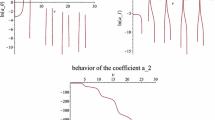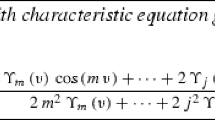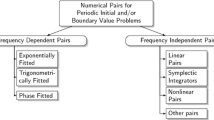Abstract
An efficient and computational effective algorithm is introduced, for the first time in the literature, in the present paper. The main properties of the scheme are: (1) the algorithm is a two-step scheme, (2) the algorithm is symmetric one, (3) it is a hight algebraic order scheme (i.e of eight algebraic order), (4) it is a three-stages algorithm, (5) the first layer of the new method is based on an approximation to the point \(x_{n-1}\), (6) the scheme has vanished phase-lag and its first, second and third derivatives, (7) the new proposed algorithm has an interval of periodicity equal to \(\left( 0, 9.8 \right) \). For the present new scheme we study: (1) its construction, (2) its error analysis (3) its stability analysis. Finally, the investigation of the effectiveness of the new algorithm leads to its application to systems of differential equations arising from the Schrödinger equation.





Similar content being viewed by others
References
Z.A. Anastassi, T.E. Simos, A parametric symmetric linear four-step method for the efficient integration of the Schrödinger equation and related oscillatory problems. J. Comput. Appl. Math. 236, 3880–3889 (2012)
A.D. Raptis, T.E. Simos, A four-step phase-fitted method for the numerical integration of second order initial-value problem. BIT 31, 160–168 (1991)
D.G. Quinlan, S. Tremaine, Symmetric multistep methods for the numerical integration of planetary orbits. Astron. J. 100(5), 1694–1700 (1990)
J.M. Franco, M. Palacios, J. Comput. Appl. Math. 30, 1 (1990)
J.D. Lambert, Numerical Methods for Ordinary Differential Systems, the Initial Value Problem (Wiley, New York, 1991), pp. 104–107
E. Stiefel, D.G. Bettis, Stabilization of Cowell’s method. Numer. Math. 13, 154–175 (1969)
G.A. Panopoulos, Z.A. Anastassi, T.E. Simos, Two new optimized eight-step symmetric methods for the efficient solution of the schrödinger equation and related problems. Match Commun. Math. Comput. Chem. 60(3), 773–785 (2008)
G.A. Panopoulos, Z.A. Anastassi, T.E. Simos, Two optimized symmetric eight-step implicit methods for initial-value problems with oscillating solutions. J. Math. Chem. 46(2), 604–620 (2009)
T.E. Simos, P.S. Williams, Bessel and Neumann fitted methods for the numerical solution of the radial Schrödinger equation. Comput. Chem. 21, 175–179 (1977)
T.E. Simos, Jesus Vigo-Aguiar, A dissipative exponentially-fitted method for the numerical solution of the Schrödinger equation and related problems. Comput. Phys. Commun. 152, 274–294 (2003)
T.E. Simos, G. Psihoyios, J. Comput. Appl. Math. 175(1), IX–IX (2005)
T. Lyche, Chebyshevian multistep methods for ordinary differential eqations. Numer. Math. 19, 65–75 (1972)
T.E. Simos, P.S. Williams, A finite difference method for the numerical solution of the Schrödinger equation. J. Comput. Appl. Math. 79, 189–205 (1997)
R.M. Thomas, Phase properties of high order almost P-stable formulae. BIT 24, 225–238 (1984)
J.D. Lambert, I.A. Watson, Symmetric multistep methods for periodic initial values problems. J. Inst. Math. Appl. 18, 189–202 (1976)
A. Konguetsof, T.E. Simos, A generator of hybrid symmetric four-step methods for the numerical solution of the Schrödinger equation. J. Comput. Appl. Math. 158(1), 93–106 (2003)
Z. Kalogiratou, T. Monovasilis, T.E. Simos, Symplectic integrators for the numerical solution of the Schrödinger equation. J. Comput. Appl. Math. 158(1), 83–92 (2003)
Z. Kalogiratou, T.E. Simos, Newton–Cotes formulae for long-time integration. J. Comput. Appl. Math. 158(1), 75–82 (2003)
G. Psihoyios, T.E. Simos, Trigonometrically fitted predictor–corrector methods for IVPs with oscillating solutions. J. Comput. Appl. Math. 158(1), 135–144 (2003)
T.E. Simos, I.T. Famelis, C. Tsitouras, Zero dissipative, explicit Numerov-type methods for second order IVPs with oscillating solutions. Numer. Algorithms 34(1), 27–40 (2003)
T.E. Simos, Dissipative trigonometrically-fitted methods for linear second-order IVPs with oscillating solution. Appl. Math. Lett. 17(5), 601–607 (2004)
K. Tselios, T.E. Simos, Runge–Kutta methods with minimal dispersion and dissipation for problems arising from computational acoustics. J. Comput. Appl. Math. 175(1), 173–181 (2005)
D.P. Sakas, T.E. Simos, Multiderivative methods of eighth algrebraic order with minimal phase-lag for the numerical solution of the radial Schrödinger equation. J. Comput. Appl. Math. 175(1), 161–172 (2005)
G. Psihoyios, T.E. Simos, A fourth algebraic order trigonometrically fitted predictor–corrector scheme for IVPs with oscillating solutions. J. Comput. Appl. Math. 175(1), 137–147 (2005)
Z.A. Anastassi, T.E. Simos, An optimized Runge–Kutta method for the solution of orbital problems. J. Comput. Appl. Math. 175(1), 1–9 (2005)
T.E. Simos, Closed Newton–Cotes trigonometrically-fitted formulae of high order for long-time integration of orbital problems. Appl. Math. Lett. 22(10), 1616–1621 (2009)
S. Stavroyiannis, T.E. Simos, Optimization as a function of the phase-lag order of nonlinear explicit two-step P-stable method for linear periodic IVPs. Appl. Numer. Math. 59(10), 2467–2474 (2009)
T.E. Simos, Exponentially and trigonometrically fitted methods for the solution of the Schrödinger equation. Acta Appl. Math. 110(3), 1331–1352 (2010)
T.E. Simos, New stable closed Newton–Cotes trigonometrically fitted formulae for long-time integration. Abstract Appl. Anal. 2012, Article ID 182536 (2012). doi:10.1155/2012/182536
T.E. Simos, Optimizing a hybrid two-step method for the numerical solution of the Schrödinger equation and related problems with respect to phase-lag. J. Appl. Math. 2012, Article ID 420387 (2012). doi:10.1155/2012/420387
Ibraheem Alolyan, T.E. Simos, A high algebraic order multistage explicit four-step method with vanished phase-lag and its first, second, third, fourth and fifth derivatives for the numerical solution of the Schrödinger equation. J. Math. Chem. 53(8), 1915–1942 (2015)
Ibraheem Alolyan, T.E. Simos, Efficient low computational cost hybrid explicit four-step method with vanished phase-lag and its first, second, third and fourth derivatives for the numerical integration of the Schrödinger equation. J. Math. Chem. 53(8), 1808–1834 (2015)
Ibraheem Alolyan, A high algebraic order predictor–corrector explicit method with vanished phase-lag and its first, second, third and fourth derivatives for the numerical solution of the Schrödinger equation and related problems. J. Math. Chem. 53(7), 1495–1522 (2015)
Ibraheem Alolyan, T.E. Simos, A family of explicit linear six-step methods with vanished phase-lag and its first derivative. J. Math. Chem. 52(8), 2087–2118 (2014)
T.E. Simos, An explicit four-step method with vanished phase-lag and its first and second derivatives. J. Math. Chem. 52(3), 833–855 (2014)
Ibraheem Alolyan, T.E. Simos, A Runge–Kutta type four-step method with vanished phase-lag and its first and second derivatives for each level for the numerical integration of the Schrödinger equation. J. Math. Chem. 52(3), 917–947 (2014)
Ibraheem Alolyan, T.E. Simos, A predictor–corrector explicit four-step method with vanished phase-lag and its first, second and third derivatives for the numerical integration of the Schrödinger equation. J. Math. Chem. 53(2), 685–717 (2015)
Ibraheem Alolyan, T.E. Simos, A hybrid type four-step method with vanished phase-lag and its first, second and third derivatives for each level for the numerical integration of the Schrödinger equation. J. Math. Chem. 52(9), 2334–2379 (2014)
G.A. Panopoulos, T.E. Simos, A new optimized symmetric 8-step semi-embedded predictor–corrector method for the numerical solution of the radial Schrödinger equation and related orbital problems. J. Math. Chem. 51(7), 1914–1937 (2013)
T.E. Simos, New high order multiderivative explicit four-step methods with vanished phase-lag and its derivatives for the approximate solution of the Schrödinger equation. Part I: construction and theoretical analysis. J. Math. Chem. 51(1), 194–226 (2013)
T.E. Simos, High order closed Newton–Cotes exponentially and trigonometrically fitted formulae as multilayer symplectic integrators and their application to the radial Schrödinger equation. J. Math. Chem. 50(5), 1224–1261 (2012)
Dimitris F. Papadopoulos, T.E. Simos, A modified Runge–Kutta–Nyström method by using phase lag properties for the numerical solution of orbital problems. Appl. Math. Inf. Sci. 7(2), 433–437 (2013)
Th. Monovasilis, Z. Kalogiratou, T.E. Simos, Exponentially fitted symplectic Runge–Kutta–Nyström methods. Appl. Math. Inf. Sci. 7(1), 81–85 (2013)
G.A. Panopoulos, T.E. Simos, An optimized symmetric 8-step semi-embedded predictor–corrector method for IVPs with oscillating solutions. Appl. Math. Inf. Sci. 7(1), 73–80 (2013)
D.F. Papadopoulos, T.E Simos, The use of phase lag and amplification error derivatives for the construction of a modified Runge–Kutta–Nyström method. Abstr. Appl. Anal. Article Number: 910624 Published: (2013)
I. Alolyan, Z.A. Anastassi, Z.A., T.E. Simos, A new family of symmetric linear four-step methods for the efficient integration of the Schrödinger equation and related oscillatory problems. Appl. Math. Comput. 218(9), 5370–5382 (2012)
Ibraheem Alolyan, T.E. Simos, A family of high-order multistep methods with vanished phase-lag and its derivatives for the numerical solution of the Schrödinger equation. Comput. Math. Appl. 62(10), 3756–3774 (2011)
Ch. Tsitouras, I. Th. Famelis, T.E. Simos, On modified Runge–Kutta trees and methods. Comput. Math. Appl. 62(4), 2101–2111 (2011)
Ch. Tsitouras, I.Th. Famelis, T.E. Simos, Phase-fitted Runge–Kutta pairs of orders 8(7). J. Comput. Appl. Math. 321 226–231 (2017)
A.A. Kosti, Z.A. Anastassi, T.E. Simos, Construction of an optimized explicit Runge–Kutta–Nyström method for the numerical solution of oscillatory initial value problems. Comput. Math. Appl. 61(11), 3381–3390 (2011)
Z. Kalogiratou, Th Monovasilis, T.E. Simos, New modified Runge–Kutta–Nystrom methods for the numerical integration of the Schrödinger equation. Comput. Math. Appl. 60(6), 1639–1647 (2010)
Th Monovasilis, Z. Kalogiratou, T.E. Simos, A family of trigonometrically fitted partitioned Runge–Kutta symplectic methods. Appl. Math. Comput. 209(1), 91–96 (2009)
T. Monovasilis, Z. Kalogiratou, T.E. Simos, Construction of exponentially fitted symplectic Runge–Kutta–Nyström methods from partitioned Runge–Kutta methods. Mediterr. J. Math. 13(4), 2271–2285 (2016)
T.E. Simos, Multistage symmetric two-step P-stable method with vanished phase-lag and its first, second and third derivatives. Appl. Comput. Math. 14(3), 296–315 (2015)
Z. Kalogiratou, Th. Monovasilis, Higinio Ramos, T.E. Simos, A new approach on the construction of trigonometrically fitted two step hybrid methods. J. Comput. Appl. Math. 303, 146–155 (2016)
Higinio Ramos, Z. Kalogiratou, Th Monovasilis, T.E. Simos, An optimized two-step hybrid block method for solving general second order initial-value problems. Numer. Algorithms 72, 1089–1102 (2016)
T.E. Simos, High order closed Newton–Cotes trigonometrically-fitted formulae for the numerical solution of the Schrödinger equation. Appl. Math. Comput. 209(1), 137–151 (2009)
A. Konguetsof, T.E. Simos, An exponentially-fitted and trigonometrically-fitted method for the numerical solution of periodic initial-value problems, Comput. Math. Appl. 45(1–3), 547–554 Article Number: PII S0898-1221(02), 00354-1 (2003)
T.E. Simos, A new explicit hybrid four-step method with vanished phase-lag and its derivatives. J. Math. Chem. 52(7), 1690–1716 (2014)
T.E. Simos, On the explicit four-step methods with vanished phase-lag and its first derivative. Appl. Math. Inf. Sci. 8(2), 447–458 (2014)
G.A. Panopoulos, T.E. Simos, A new optimized symmetric embedded predictor–corrector method (EPCM) for initial-value problems with oscillatory solutions. Appl. Math. Inf. Sci. 8(2), 703–713 (2014)
G.A. Panopoulos, T.E. Simos, An eight-step semi-embedded predictor–corrector method for orbital problems and related IVPs with oscillatory solutions for which the frequency is unknown. J. Comput. Appl. Math. 290, 1–15 (2015)
Fei Hui, T.E. Simos, A new family of two stage symmetric two-step methods with vanished phase-lag and its derivatives for the numerical integration of the Schrödinger equation. J. Math. Chem. 53(10), 2191–2213 (2015)
LGr Ixaru, M. Rizea, Comparison of some four-step methods for the numerical solution of the Schrödinger equation. Comput. Phys. Commun. 38(3), 329–337 (1985)
L.Gr. Ixaru, M. Micu, Topics in Theoretical Physics (Central Institute of Physics, Bucharest, 1978)
L.Gr Ixaru, M. Rizea, A Numerov-like scheme for the numerical solution of the Schrödinger equation in the deep continuum spectrum of energies. Comput. Phys. Commun. 19, 23–27 (1980)
J.R. Dormand, M.E.A. El-Mikkawy, P.J. Prince, Families of Runge–Kutta–Nyström formulae. IMA J. Numer. Anal. 7, 235–250 (1987)
J.R. Dormand, P.J. Prince, A family of embedded Runge–Kutta formulae. J. Comput. Appl. Math. 6, 19–26 (1980)
G.D. Quinlan, S. Tremaine, Symmetric multistep methods for the numerical integration of planetary orbits. Astron. J. 100, 1694–1700 (1990)
A.D. Raptis, A.C. Allison, Exponential-fitting methods for the numerical solution of the Schrödinger equation. Comput. Phys. Commun. 14, 1–5 (1978)
M.M. Chawla, P.S. Rao, An Noumerov-typ method with minimal phase-lag for the integration of second order periodic initial-value problems II explicit method. J. Comput. Appl. Math. 15, 329–337 (1986)
M.M. Chawla, P.S. Rao, An explicit sixth-order method with phase-lag of order eight for \(y^{\prime \prime }=f(t, y)\). J. Comput. Appl. Math. 17, 363–368 (1987)
T.E. Simos, A new Numerov-type method for the numerical solution of the Schrödinger equation. J. Math. Chem. 46, 981–1007 (2009)
A. Konguetsof, Two-step high order hybrid explicit method for the numerical solution of the Schrödinger equation. J. Math. Chem. 48, 224–252 (2010)
A.D. Raptis, J.R. Cash, A variable step method for the numerical integration of the one-dimensional Schrödinger equation. Comput. Phys. Commun. 36, 113–119 (1985)
A.C. Allison, The numerical solution of coupled differential equations arising from the Schrödinger equation. J. Comput. Phys. 6, 378–391 (1970)
R.B. Bernstein, A. Dalgarno, H. Massey, I.C. Percival, Thermal scattering of atoms by homonuclear diatomic molecules. Proc. R. Soc. Ser. A. 274, 427–442 (1963)
R.B. Bernstein, Quantum mechanical (phase shift) analysis of differential elastic scattering of molecular beams. J. Chem. Phys. 33, 795–804 (1960)
T.E. Simos, Exponentially fitted Runge–Kutta methods for the numerical solution of the Schrödinger equation and related problems. Comput. Mater. Sci. 18, 315–332 (2000)
Kenan Mu, T.E. Simos, A Runge–Kutta type implicit high algebraic order two-step method with vanished phase-lag and its first, second, third and fourth derivatives for the numerical solution of coupled differential equations arising from the Schrödinger equation. J. Math. Chem. 53, 1239–1256 (2015)
Minjian Liang, T.E. Simos, Minjian Liang, T.E. Simos, A new four stages symmetric two-step method with vanished phase-lag and its first derivative for the numerical integration of the Schrödinger equation. J. Math. Chem. 54(5), 1187–1211 (2016)
Xiaopeng Xi, T.E. Simos, A new high algebraic order four stages symmetric two-step method with vanished phase-lag and its first and second derivatives for the numerical solution of the Schrödinger equation and related problems. J. Math. Chem. 54(7), 1417–1439 (2016)
F. Hui, T.E. Simos, Hybrid high algebraic order two-step method with vanished phase-lag and its first and second derivatives. MATCH Commun. Math. Comput. Chem. 73, 619–648 (2015)
Zhou Zhou, T.E. Simos, A new two stage symmetric two-step method with vanished phase-lag and its first, second, third and fourth derivatives for the numerical solution of the radial Schrödinger equation. J. Math. Chem. 54, 442–465 (2016)
Fei Hui, Theodore E. Simos, Four stages symmetric two-step P-stable method with vanished phase-lag and its first, second, third and fourth derivatives. Appl. Comput. Math. 15(2), 220–238 (2016)
Wei Zhang, T.E. Simos, A high-order two-step phase-fitted method for the numerical solution of the Schrödinger equation. Mediterr. J. Math. 13(6), 5177–5194 (2016)
L. Zhang, T.E. Simos, An efficient numerical method for the solution of the Schrödinger equation. Adv. Math. Phys. 2016 Article ID 8181927. doi:10.1155/2016/8181927
M. Dong, T.E. Simos, A new high algebraic order efficient finite difference method for the solution of the Schrödinger equation. Filomat (in press)
R. Lin, T.E. Simos, A two-step method with vanished phase-lag and its derivatives for the numerical solution of the Schrödinger equation. Open Phys. 14, 628–642 (2016)
H. Ning, T.E. Simos, A low computational cost eight algebraic order hybrid method with vanished phase-lag and its first, second, third and fourth derivatives for the approximate solution of the Schrödinger equation. J. Math. Chem. 53(6), 1295–1312 (2015)
Zhiwei Wang, T.E. Simos, An economical eighth-order method for the approximation of the solution of the Schrödinger equation. J. Math. Chem. 55, 717–733 (2017)
S. Kottwitz, LaTeX Cookbook (Packt Publishing Ltd., Birmingham, 2015), pp. 231–236
Author information
Authors and Affiliations
Corresponding author
Ethics declarations
Conflict of interest
The authors declare that they have no conflict of interest.
Informed consent
Consent to submit has been received explicitly from all co-authors, as well as from the responsible authorities—tacitly or explicitly—at the institute/organization where the work has been carried out, before the work is submitted.
Additional information
Highly Cited Researcher (http://isihighlycited.com/), Active Member of the European Academy of Sciences and Arts. Active Member of the European Academy of Sciences. Corresponding Member of European Academy of Arts, Sciences and Humanities.
Authors whose names appear on the submission have contributed sufficiently to the scientific work and therefore share collective responsibility and accountability for the results.
Electronic supplementary material
Below is the link to the electronic supplementary material.
Rights and permissions
About this article
Cite this article
Ma, J., Simos, T.E. An efficient and computational effective method for second order problems. J Math Chem 55, 1649–1668 (2017). https://doi.org/10.1007/s10910-017-0753-9
Received:
Accepted:
Published:
Issue Date:
DOI: https://doi.org/10.1007/s10910-017-0753-9
Keywords
- Phase-lag
- Derivative of the phase-lag
- Initial value problems
- Oscillating solution
- Symmetric
- Hybrid
- Multistep
- Hybrid
- Schrödinger equation




